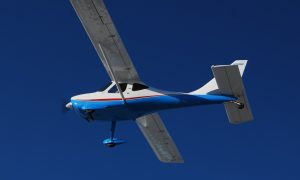 I did my required spin training for the instructor’s rating in the second, demo GlaStar. (Learned to fly in a Luscombe, didn’t enjoy spinning that airplane.) We never spun the prototype because the original wings were not nearly as strong as the production parts, but in 1400 hours of some tough flying they held up fine. The GlaStar appears to be a fine spinning airplane, certainly up through two full turns. I haven’t taken it more than that. It has an interesting requirement to enter the spin, but enters easily and quickly by putting it into a stall, pushing full rudder and while at the same time giving it a burst of power and returning to idle to “kick” the tail around. It recovers cleanly with the neutral ailerons and opposite rudder. By the way, we did not wear chutes as they are not required for the instructors training requirement. I know of various GlaStars that have been spun/recovered successfully. Haven’t heard anything bad, but also don’t know maximum demonstrated turns. I WOULD NOT SPIN a GlaStar with fuel in the wing aux tanks. That’s a lot of centrifugal weight and moment being held by that outboard rib.
I did my required spin training for the instructor’s rating in the second, demo GlaStar. (Learned to fly in a Luscombe, didn’t enjoy spinning that airplane.) We never spun the prototype because the original wings were not nearly as strong as the production parts, but in 1400 hours of some tough flying they held up fine. The GlaStar appears to be a fine spinning airplane, certainly up through two full turns. I haven’t taken it more than that. It has an interesting requirement to enter the spin, but enters easily and quickly by putting it into a stall, pushing full rudder and while at the same time giving it a burst of power and returning to idle to “kick” the tail around. It recovers cleanly with the neutral ailerons and opposite rudder. By the way, we did not wear chutes as they are not required for the instructors training requirement. I know of various GlaStars that have been spun/recovered successfully. Haven’t heard anything bad, but also don’t know maximum demonstrated turns. I WOULD NOT SPIN a GlaStar with fuel in the wing aux tanks. That’s a lot of centrifugal weight and moment being held by that outboard rib.
First and major point: Your GlaStar WILL HAVE variations in rigging, control inputs and limits, engine, prop, CG, etc. from the factory demo GlaStar which is going to change its spin entry and characteristics. This is a major reason S-H won’t enter this area of publishing performance. The builder is the factory and their GlaStar may/will be different. Secondly, this was not an exhaustive test, but teaching me how the GlaStar entered, spun and recovered by an experienced instructor. The demo GlaStar seemed to require at a stall both the addition of full rudder and a slight burst then reduction of power to enter a spin. My full cross-controlling at stall and no resultant spin that I’ve done on thousands of demo flights ALWAYS INCLUDED LOTS OF SUSTAINED POWER.
Question: Does it go over the top on entry?
Answer: YES
Question: Do you have to keep full stick and rudder to hold it in?
Answer: NO, full back stick (up elevator) needed to be held but the rudder could be moved to neutral once it entered the spin and it would stay in the spin.
Question: Will it recover with neutral controls?
Answer: NO, it generally needed application of full opposite rudder to stop the turning. Any application of opposite aileron while in the spin only aggravated the spin.
Question: Do you lead with rudder to stop the rotation and follow with stick?
Answer: YES, the standard spin recovery applies with the understanding that opposite rudder is applied first.
Question: How much airspeed build up in spin and recovery?
Answer: Surprisingly quickly you could get to 120 to 140 knots. When spin entry with flaps down it picks up speed so fast you will exceed the flap limit (75 knots) unless you get your hand to the flap handle and start removing flap very quickly.
Question: How much altitude lost in two turns and recovery etc.?
Answer: 800 to 1,000 feet.
Again, remember that Stoddard-Hamilton has not approved the GlaStar for spins. You spin the aircraft at totally your own risk. Unless you are trained in spinning aircraft always get a good instructor who is, if you decide to enter this area of flight (or rapid descent could be a better description.)
Tim Johnson’s articles are his own perspective and reflect over 1,000 hours of safely flying the prototype GlaStar in demonstration, cross-country, and air-show flights. Your experience, training, GlaStar airplane, and local situations may require different procedures. Be safe! Never attempt something just because someone else did it! The current GlaStar Owner’s Manual and current FAA and/or local regulations are your overriding guides. Airspeeds used are KIAS (indicated airspeed in knots).



